

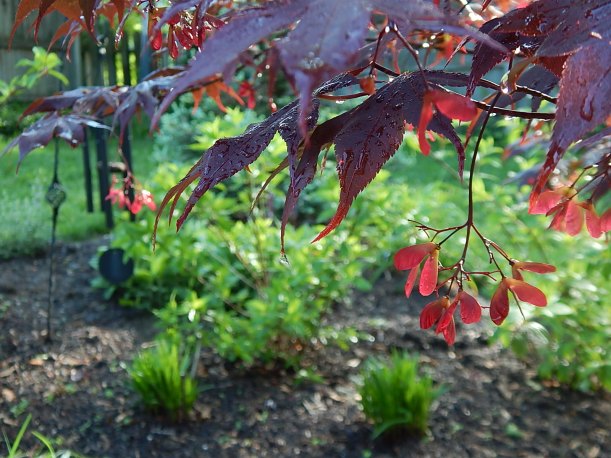
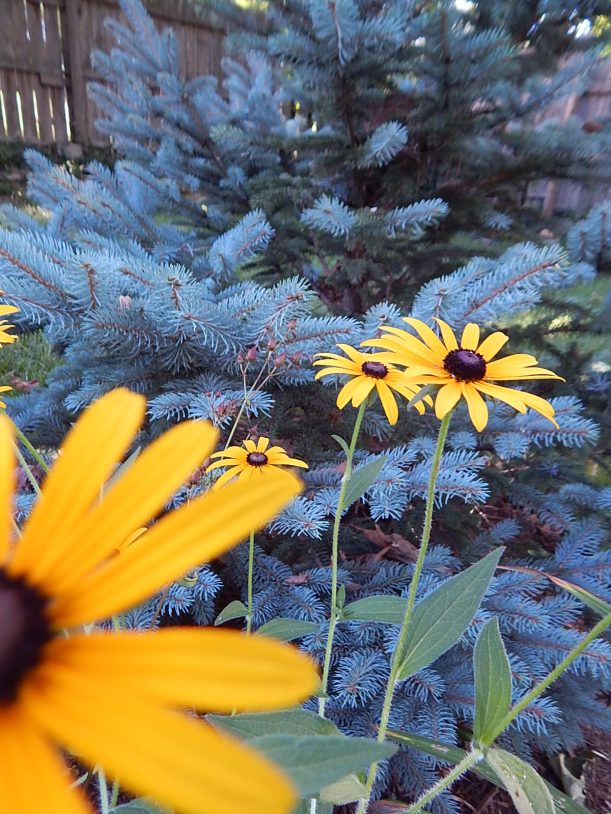
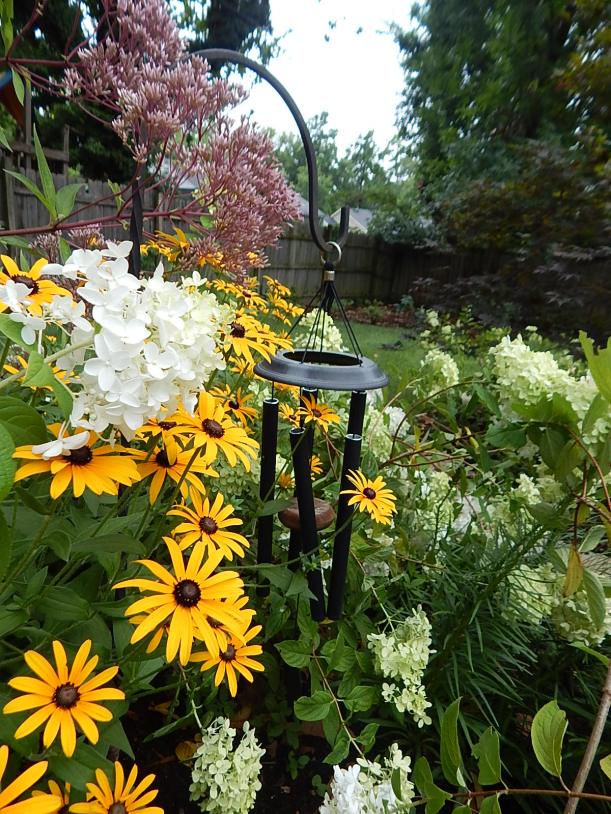

by mjarz 2 Comments
 Hostas have so many of the elements I look for in a plant. Easy to care for. Can be divided. Comes in lots of varieties, both big and small. But truth be told, I’ve not always been a big fan of them–even though they have been in every garden I have planted. You’d be hard pressed to find St. Louis garden that doesn’t incorporate hostas into its design. These are workhorse plants in this part of the Midwest and they go well in many applications.
Hostas have so many of the elements I look for in a plant. Easy to care for. Can be divided. Comes in lots of varieties, both big and small. But truth be told, I’ve not always been a big fan of them–even though they have been in every garden I have planted. You’d be hard pressed to find St. Louis garden that doesn’t incorporate hostas into its design. These are workhorse plants in this part of the Midwest and they go well in many applications.
 My fondness for hostas is growing. This plant is an essential element to my shade garden and I enjoy looking at them every day. I love the hosta in the photo above (taken in May) but will probably move it next year. Even though it is encased by the oakleave hydrangea, which filters the sunlight, it gets too much sun and by July it looks like its about to burn up. There are “sun loving” hostas but don’t be fooled, this is plant really a shade lover.
My fondness for hostas is growing. This plant is an essential element to my shade garden and I enjoy looking at them every day. I love the hosta in the photo above (taken in May) but will probably move it next year. Even though it is encased by the oakleave hydrangea, which filters the sunlight, it gets too much sun and by July it looks like its about to burn up. There are “sun loving” hostas but don’t be fooled, this is plant really a shade lover.

Too much sun? Not enough water? Both I’m afraid. I got wise and moved any hosta in this area and, yes, upped the water.
So why the growing affection for this hardy perennial? As they say in real estate parlance: Location, location, location. That’s right, I think I have finally found the right spot for them. And, I like the mix of perennials they’re planted with. Shape and texture, the keys to any garden, really stand out in a shade garden. Some have larger leaves than others and they are mingling in the bed with the tall, delicate shapes of fern, deeped lobed leaves of heuchera, spikey and brightly colored Japanese forest grass and the serrated leaves of astilbe, whose plume is to die for.

The blue hue of “Frances Williams” (center left) stands out against all the other green in the garden bed. This variety is a welcome contrast to the bright green Japanese forest grass (hakonechloa).

Hostas like water and Frances Williams is no exception.Its leaves become wider as it matures.
Moisture is another important consideration when placing hostas. I have learned the hard way that they do not do well in dry shade. Mine are mostly planted in a bed with a bunch of other moisture lovers, mainly fern and astilbe. They also like slightly acidic soil which is in abundance in my garden.
Hosta’s flower is nothing to speak of so its appeal is its foliage. I’ve planted hostas whose foliage have a spectrum of hues from citron with greenish/blue streaking to blue with creamy yellow edging and deeper green with white edging.

I’d like to share with you the names of the hosta varieties I have in the yard, but I don’t know them. Many of the plants in my garden are from the local area garden club sales, friends gardens, or were in the yard when I moved in, and they didn’t come with a tag describing their variety. Because they grow so well in our USDA Zone 6a climate, I am a big fan of dividing hostas and placing them throughout the garden beds.

Surrounded by flowers in garden beds edging the patio, the cool shade bed is a welcome sight.
by mjarz 2 Comments
Here’s a quick peek at the goings on in my Arch City backyard. So happy it’s spring!

Bloodgood Japanese maple (Acer palmatum) starts to leaf.

Pretty pink tulips in bloom. Fond reminders of a family trip to the Netherlands last fall.

Clematis begins its winding growth. Transplanted in the fall from a container, it seems to like its new spot. This is the second year for this plant and I think I’m falling in love! 🙂

Bright chartreuse and green leaves of Japanese forest grass (Hakonechloa macra) after a rain.

Pretty pink and purple rhododendron in full bloom. Note the rain barrel in the back. More about that in a coming post.

Husker Red penstemon (Penstemon digitalis) bursting forth. This is one of my favorites. I love the purple/green leaves with red veining. Before too long it will be in bloom.
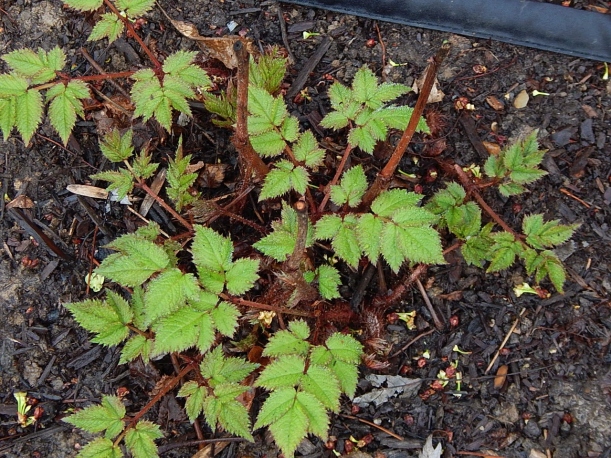
Hairy stemmed astilbe (Astilbe chinensis) are planted near the Japanese forest grass. But there are other signs of life in my shade garden: pointy tips of hosta emerging, curly coral bell (heuchera) leaves, rosy colored tips of Solomon seal (polygonatum biflorum), lemon-lime creeping Jenny (lysimachia nummularia), and soon, ferns, glorious elegant ferns.
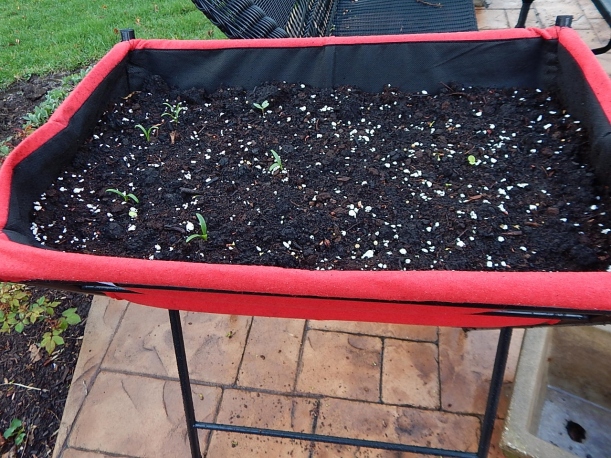
The great seed planting experiment shows signs of life: cool season greens and brocolli.

Spring rainfall, cool night time temperatures and warmer days make possible all of the above.
by mjarz 2 Comments
by mjarz 3 Comments

Astilbe circle the base of the concrete stand. I placed the armillary sphere on top as a last-minute gesture. My original plan is to put a container oozing with plant atop the stand. But I do kind of like this look.
It’s just after 6 p.m. My fingernails are filthy, my shoes are muddied (and in the garage), I have hat hair, my lower back is talking to me, and the shade garden bed that I dreamed about all winter has begun to take shape.
It was a very good day in the garden.

The long view of the bed, looking toward the top of the bed. There’s plenty of room remaining for the caladium bulbs on order and Japanese forest grass. And as time goes by, I think I will add more heuchera to the front.
This was a day of moving plants from one bed to another, checking the layout I painstakingly mapped out in the midst of winter–desperate for a spring day like today–and making modifications on the fly. My daughter Louise and I hoisted a concrete plant stand and moved it to the middle of the bed, which could have something to do with the backache. Here is what has gone into this fence-line shade bed that is anchored at the top by a maple tree and curves at the bottom into the wet “problem zone” of the yard:
Still to come: Caladium “White Queen,” Japanese forest grass (Hakonechloa macra) “Aureola”, creeping jenny. And mulch, lots of mulch.
Dear readers, how does your garden grow?
Advice and Tips on How to Garden
Our garden, gardens visited, occasional thoughts and book reviews
Horticulturist, Arborist and Garden Columnist
Thoughts about life, creating, and gardening....
Musings about gardening, the natural world and things creative.
Learning life's lessons in the garden!
the great outdoors, wellbeing and life in the North
Journeys In St. Louis Gardening and Beyond
America's Favorite Rose Gardener
A region, a garden, a frame of mind...
"How quickly comes the sun when first it sets its mind to rise." - - j. s. v.
tales from deep in my soil
Cariboo-Grown & Cariboo-Hardy Perennials. Since 1991.
A Gardening Blog. Mostly
.....and nurturing my soul